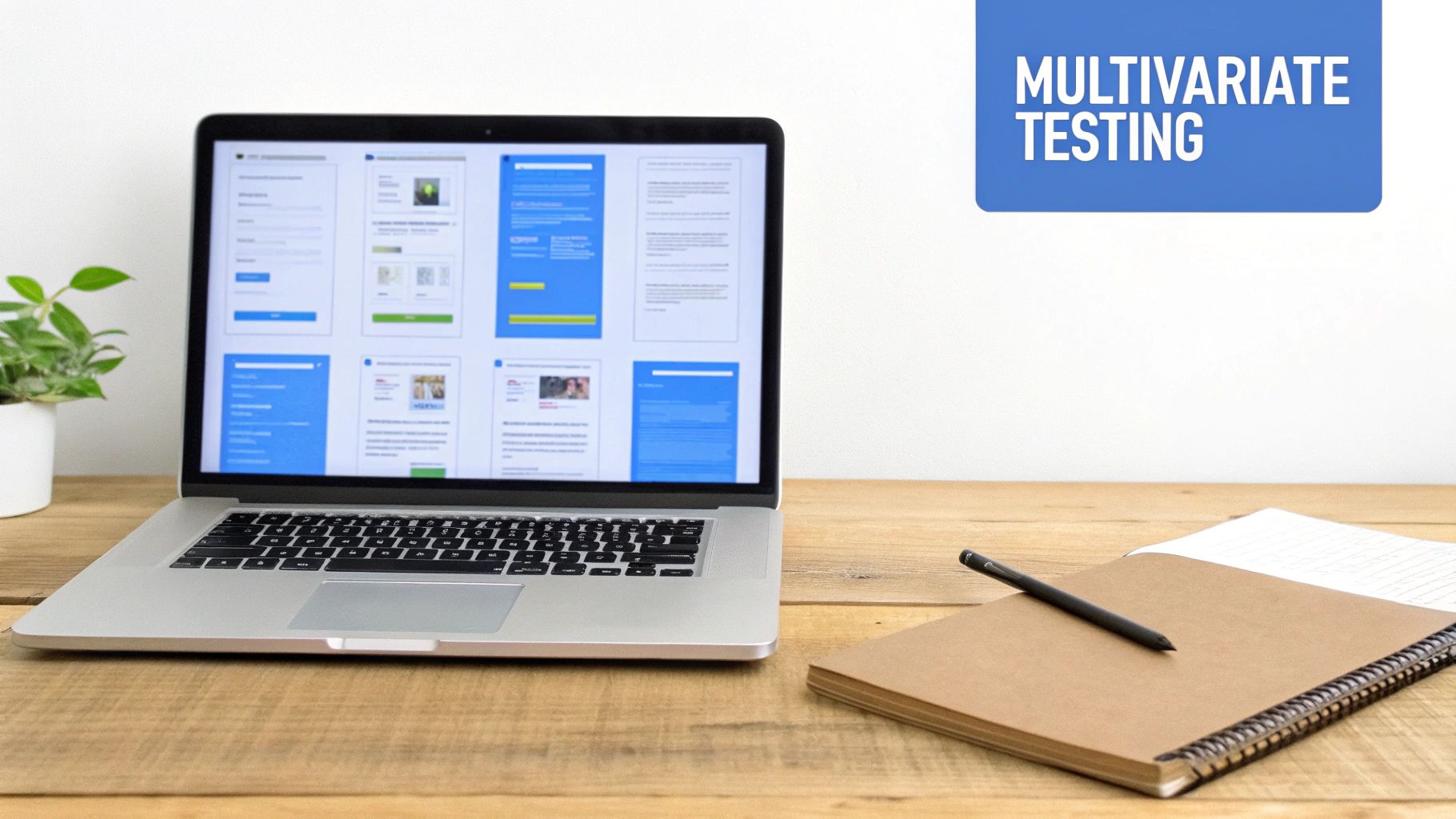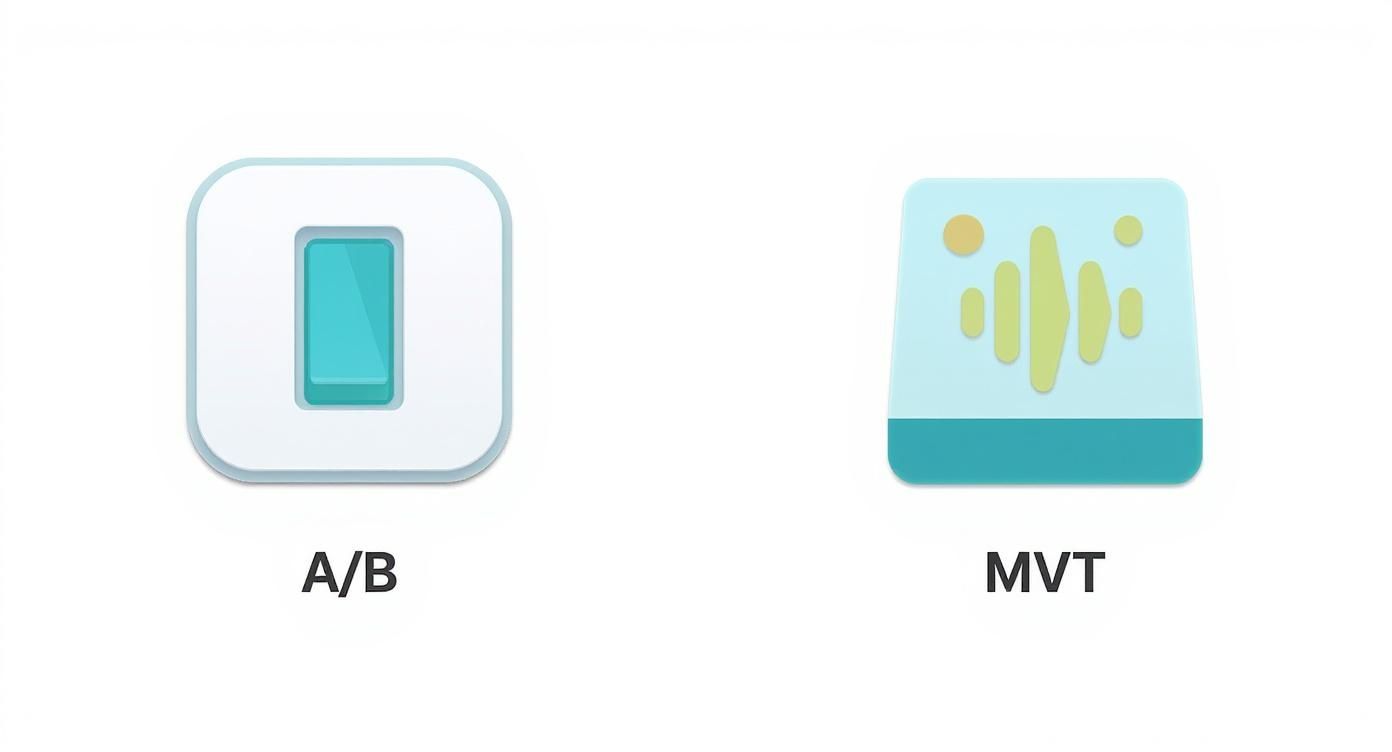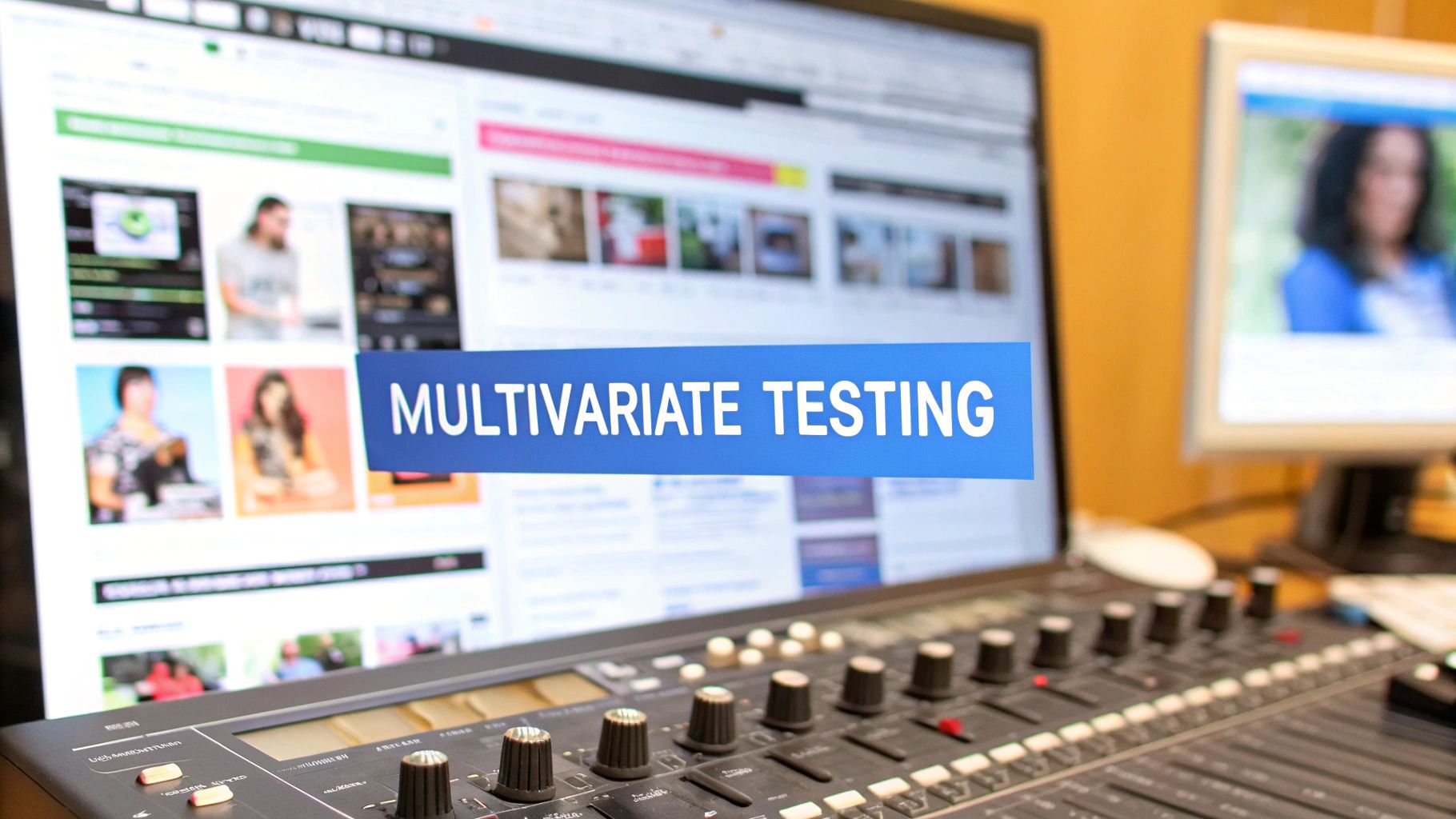Summary
Meta Description: Discover what multivariate testing is and how it unlocks deeper insights than A/B testing. Our expert guide shows you how to boost conversions.
Ever wondered if your killer headline would perform even better with a different hero image? Or if changing your button color and its text at the same time could unlock a massive lift in clicks?
Answering these kinds of questions is exactly what multivariate testing (MVT) is for. So, what is multivariate testing, really?
It’s an optimization method where you test multiple variations of different page elements—like a headline, an image, and a call-to-action button—all at once. The goal isn't just to see which element is best, but to find the perfect combination that drives your goals, like boosting conversions or sign-ups.
Your Quick Guide to Multivariate Testing

Think of it like this: instead of running separate A/B tests for your headline, then your image, and then your button, multivariate testing lets you tackle them all in one fell swoop. It moves beyond simple, one-change experiments to give you a much deeper understanding of how your audience thinks.
Let's say you want to perfect a landing page. You could have three headline options, two images, and two button texts. A multivariate test creates every possible combination (3 x 2 x 2 = 12 versions) and shows them to different segments of your audience to see which recipe comes out on top.
Understanding the Core Idea
At its heart, MVT is all about interaction. It doesn’t just tell you which headline is best; it tells you which headline performs best with which image. This is its real power compared to simpler methods like A/B testing, which only pits one distinct version of a page against another (Version A vs. Version B).
Multivariate testing reveals not just which element wins, but how different elements work together to influence user behavior. It’s about finding the perfect recipe, not just the best single ingredient.
By analyzing these interactions, you get much richer insights. You might discover that a bold, direct headline paired with a product-focused image crushes all other combinations—a subtle but powerful insight you’d completely miss with isolated A/B tests.
This makes MVT a go-to tool for fine-tuning high-traffic pages where even small, combined improvements can lead to huge performance gains. Are you ready to find your winning combination?
Multivariate Testing At a Glance
To boil it all down, here’s a quick snapshot of what multivariate testing is all about.
Now that you've got the basics down, let's dive deeper into how this powerful technique can seriously upgrade your optimization efforts.
The True Power of Multivariate Testing

It’s one thing to know what multivariate testing is, but it’s another to grasp what it can truly do for you. The real value isn’t just about scoring quick wins; it’s about unlocking a deep, strategic understanding of your audience that A/B testing can’t provide on its own.
Think of it this way: an A/B test might tell you that a landing page with a video background beats one with a static image. That’s a great piece of information. But what if that winning video background actually hurts your conversions when paired with your current headline?
That’s where multivariate testing steps in. It reveals the synergistic effect between all the different elements on your page. You stop asking "which headline is best?" and start asking "which headline works best with a video?" or "which CTA button drives more clicks when placed next to this specific testimonial?"
Uncovering Hidden Conversion Opportunities
Often, the biggest performance boosts aren't hiding in one dramatic change. They’re buried in the subtle, almost invisible interactions between your page elements. A multivariate test is like a treasure map for finding these hidden gems.
By testing dozens of combinations at once, you can stumble upon a powerful mix you would have never dreamed up on your own. For example, maybe a softer, benefit-driven headline only skyrockets conversions when it's combined with a gentler color palette on the CTA button. An A/B test would never reveal that connection.
These are the kinds of insights that are absolutely essential if you want to master sales funnel optimization and see real, meaningful growth.
The greatest strength of multivariate testing is its ability to measure the impact of combined changes. It moves your optimization from guessing which ingredient is best to finding the perfect recipe for the entire user experience.
This approach lets you fine-tune your pages with surgical precision, making sure every single element is working together in perfect harmony.
Gaining Deeper User Behavior Insights
Beyond just lifting your conversion rates, MVT hands you a rich set of data about user psychology. When you learn which combinations resonate the most, you learn what truly motivates your audience.
Do they respond better to urgent, punchy language paired with bold visuals? Or do they prefer social proof placed right next to a clear value proposition? Answering these questions helps you build better campaigns from the ground up.
This deeper level of understanding is invaluable. It helps you write more persuasive copy, design user experiences that genuinely connect, and ultimately, stop making isolated tweaks. Instead, you start building a comprehensive, data-backed picture of what makes your customers act.
Multivariate Testing vs A/B Testing Explained
Picking the right testing method is a huge decision, and it directly shapes how successful your optimization efforts will be. While both multivariate testing (MVT) and A/B testing are designed to improve performance, they work in completely different ways and answer very different questions. Getting this distinction right is the first step to building a smart testing strategy.
Think of it this way: A/B testing is like a light switch. You have two clear choices—Version A (on) and Version B (off). The goal is simple: find out which one works better. It's a direct comparison, making it perfect for testing big, bold changes like a complete page redesign or a brand-new value proposition.
Multivariate testing, on the other hand, is more like a sound mixing board. Instead of one switch, you have a whole panel of dials you can tweak at the same time—one for the headline, another for the image, and a third for the call-to-action (CTA) button. The goal here is to find the perfect harmony by learning how each individual setting interacts with all the others.
Key Differences at a Glance
The real difference comes down to the question each test answers. A/B testing asks, "Which page design is better?" It’s a broad, decisive approach. MVT, however, asks, "Which combination of elements is best?" This gives you a much deeper, more granular understanding of what really drives your users.
Here’s a quick rundown of the most important distinctions:
- Approach: A/B testing is your go-to for testing sweeping changes. It pits two or more completely different page versions against each other to find a clear winner. You can get a deeper dive into the basics in our detailed guide on A/B testing for landing pages.
- Insights: MVT is all about discovering how different elements play off one another. You might find out that your punchy new headline only converts well when it's paired with a specific product image—an insight a simple A/B test would completely miss.
- Complexity: A/B tests are generally easier to set up and don't need as much traffic to get a reliable result. MVT is inherently more complex because it has to create and test so many different combinations, which requires a more careful setup and analysis.
The choice isn't about which method is better overall, but which one is right for what you're trying to achieve right now. Use A/B testing for big, evolutionary leaps and MVT for revolutionary refinement.
Often, the decision comes down to your website's traffic volume and your immediate optimization goals.
Traffic and Conversion Impact
This is where the rubber really meets the road. Because MVT tests so many combinations at once, it needs a lot more traffic to produce a statistically significant result.
Let’s say a big e-commerce site wants to test three different headlines, two hero images, and two call-to-action buttons. That creates 12 unique combinations (3 × 2 × 2). If each version needs just 1,000 visitors to get a clear signal, the entire test would require at least 12,000 visitors. That's way more than a simple A/B test would need.
But the potential payoff can be massive. Industry reports have shown that well-executed multivariate tests can lift conversion rates by up to 30%, blowing the typical 5-10% lifts from A/B tests out of the water. It just goes to show how valuable it is to understand the complex interactions between variables instead of just looking at isolated changes.
A/B Testing vs Multivariate Testing: Which Should You Use?
So, how do you decide? It boils down to your goals, traffic, and how deep you want to go. This table breaks down the core differences to help you choose the right tool for the job.
Ultimately, if you have a lower-traffic site or need quick answers on big-picture changes, stick with A/B testing. But if you have a high-traffic site and want to squeeze every last drop of performance out of a critical page, the deep, nuanced insights from multivariate testing are invaluable.
How to Run a Successful Multivariate Test
Knowing the theory is one thing, but actually putting a multivariate test into practice is where the magic happens. A successful test isn't a shot in the dark; it’s a structured, methodical journey that takes you from a clear question to a data-backed answer. If you rush the process or skip steps, you'll just end up with confusing results or wasted traffic.
This framework will walk you through launching your own multivariate test, step-by-step. Follow it, and you'll sidestep the common pitfalls and get results that are both statistically solid and genuinely useful.
Step 1: Form a Strong Hypothesis
Every great test starts with a strong hypothesis—not just a random guess. A good hypothesis is a clear, testable statement that connects a change you're proposing to an outcome you expect. It should be built on a foundation of data, whether that's from your analytics, user feedback, heatmaps, or even insights from past A/B tests.
Don't just say, "Let's try a new button." A real hypothesis sounds more like this: "By changing the button text from 'Sign Up' to 'Get Started Now' and using a green color instead of blue, we will increase clicks by 15%. We believe this is because the new text creates more urgency and the green color provides a stronger visual cue."
A solid hypothesis always has three key ingredients:
- The Change: What specific elements and variations are you testing?
- The Expected Outcome: Which metric are you trying to move (e.g., conversion rate, click-through rate)?
- The Rationale: Why do you think this change will work?
This structure forces you to think critically about your goals and makes sure your test is actually designed to answer a meaningful business question.
The infographic below really nails the difference between a simple A/B test and the more complex, combination-focused approach of multivariate testing.

Think of it this way: an A/B test is like an on/off switch, but a multivariate test is like a sound mixer. It lets you fine-tune each individual component to find that perfect harmony.
Step 2: Identify Key Variables and Variations
Once you have your hypothesis, it's time to pick the specific elements (variables) you want to test and the different versions (variations) for each. Be strategic here. You want to focus on the high-impact stuff that’s most likely to influence user behavior—things like your headline, hero image, call-to-action (CTA), or the main value propositions.
Resist the temptation to test everything at once. Remember, every new variation you add makes the number of combinations grow exponentially. More combinations mean you need a lot more traffic to get a reliable result.
A good starting point is to pick 2-4 high-impact elements and create 2-3 distinct variations for each. This keeps the test manageable while still giving you rich insights into how different elements play off each other.
For example, a test on a landing page might include:
- Headline: One focused on benefits, another on features.
- Hero Image: A clean product shot vs. a lifestyle image showing the product in action.
- CTA Button Text: "Buy Now" vs. "Add to Cart."
This setup (2x2x2) creates eight unique combinations that will be tested against your original page.
Step 3: Calculate Traffic and Test Duration
Before you hit "launch," you have to make sure you actually have enough traffic to reach statistical significance. That's the point where you can be confident your results aren't just random luck. If you don't have enough traffic, your test will either drag on for months or give you data you can't trust.
Use an online sample size calculator to figure out how many visitors each combination needs. This calculation depends on your current conversion rate and the minimum improvement you want to be able to detect. For example, spotting a tiny 5% lift requires way more traffic than spotting a big 25% lift.
Be realistic with your timeline. If the calculator says your test needs to run for six months, you're probably testing too many variations for your current traffic. In that case, it's time to simplify the test by cutting back on the number of variables or variations.
Step 4: Set Up the Test and Analyze Results
With a solid plan in place, it’s time to bring your test to life using a dedicated tool. Platforms like Optimizely, VWO, or Adobe Target are built for this kind of work. They let you create your variations and will automatically handle splitting the traffic among all the different combinations.
If you're exploring your options, this guide on the best conversion rate optimisation software is a great resource.
Once you launch the test, let it run. Don't fall into the trap of peeking at the results every day and declaring an early winner. Traffic patterns and user behavior can swing wildly from one day to the next, so you need to let the data mature.
When the test finally concludes, it's time to analyze the results and see which combination came out on top. But don't stop there. The real gold is in understanding why it won. Did one headline consistently crush it, no matter what image it was paired with? Did a specific CTA text boost conversions across the board? These interaction effects are where you'll find the most valuable, long-term insights for your entire marketing strategy.
Best Practices for Effective Multivariate Testing

Running a multivariate test is one thing, but getting clear, actionable results from it? That's a whole different ball game. To avoid drowning in confusing data or wasting valuable traffic, you need a disciplined approach from the very beginning.
Following a few key best practices ensures your tests are built for success, delivering real insights that genuinely move the needle.
Focus on High-Impact Elements First
Not all page elements are created equal. Let's be honest, changing the color of a footer link probably won't have the same impact as rewriting your main headline or redesigning your call-to-action. It's tempting to test everything, but that's a fast track to an unmanageable number of combinations.
Before launching any test, ask yourself: what are the absolute most persuasive elements on this page? Start there. By focusing your energy on the components that do the heavy lifting, you guarantee your results will be significant.
Here are a few high-impact elements to get you started:
- Headline and Sub-headline: This is your first impression. It sets the tone for the entire user experience.
- Call-to-Action (CTA) Button: The text, color, size, and even its placement can dramatically influence clicks.
- Hero Image or Video: Your main visual is crucial for building an emotional connection and grabbing attention.
- Offer or Value Proposition: How you frame your offer matters. Test different angles, like "50% Off" versus "Buy One, Get One Free."
Concentrating on these critical areas gives you the best shot at seeing a meaningful lift.
Ensure Your Variations Are Distinct
This one is critical. If your variations are too similar, your test results will be inconclusive. Testing two headlines that are just slightly reworded is a recipe for ambiguity, and you won't learn anything about what truly motivates your audience.
Make your variations meaningfully different. They should represent distinct psychological approaches. For instance, instead of testing "Get Your Free Trial" against "Start Your Free Trial," pit a benefit-driven CTA like "Begin Optimizing Now" against a direct one like "Create Your Account."
A successful multivariate test isn't just about finding a winner; it's about understanding why a particular combination resonates with your audience. Drastically different variations give you clearer insights into user psychology.
The same goes for visuals. Don't just test two nearly identical stock photos. Try a product-focused image against a lifestyle shot of someone happily using your product. You're testing different emotional triggers, not just minor cosmetic tweaks.
Avoid Common Multivariate Testing Mistakes
Knowing what not to do is just as important as knowing what to do. Plenty of promising tests have been derailed by a few common, completely avoidable errors.
One of the biggest culprits is testing too many elements on a low-traffic site. The classic approach is a full factorial design, where every single combination is tested equally. But if you have 4 elements with 3 variations each, that's 81 (3⁴) combinations! For most websites, that's just not practical.
This is where smarter statistical methods like Taguchi methods come in. These approaches test a smaller, strategically chosen subset of combinations, allowing you to get reliable insights without needing a massive sample size. For instance, a Taguchi design might reduce a 27-combination test down to just 9, making it far more manageable. You can dive deeper into the history of these advanced methods on Wikipedia.
Here are a few other pitfalls to steer clear of:
- Calling a Test Too Early: Traffic fluctuates. Don't end a test the second one variation pulls slightly ahead. Let it run until you hit your predetermined sample size to avoid a false positive.
- Ignoring Statistical Significance: A 5% lift doesn't mean much if your confidence level is only 70%. Wait for a confidence level of 95% or higher before you pop the champagne and declare a winner.
- Testing During Atypical Periods: Avoid running tests during major holidays, huge sales events, or any other time when your traffic patterns are out of the ordinary. This can seriously skew your results and lead to flawed conclusions.
Applying Your Multivariate Testing Insights
The real magic of testing isn’t just finding a single winning page—it's about building a deep, almost intuitive understanding of your audience. Think of multivariate testing as your secret weapon for this kind of data-driven optimization. It gives you insights that a simple, isolated A/B test just can’t touch.
By showing you how different elements play off each other, MVT helps you move beyond just scoring simple wins. You don’t just learn that a new headline works; you learn that it works best when you pair it with a specific image and a certain call-to-action. This is how you unlock massive conversion potential—by optimizing the entire user experience, not just swapping out single pieces. Your marketing simply gets smarter with every test you run.
Take the Next Step
The insights you pull from a well-run multivariate test are incredibly valuable. You can take what you’ve learned about your audience’s preferences and apply it to future campaigns, ad copy, and even product development.
Ready to put this into action?
- Identify a high-impact page: Pick a page on your site that gets a good amount of traffic but you know could be doing better.
- Brainstorm potential variables: List out the key elements you think have the biggest sway on user behavior. We're talking headline, hero image, CTA, value proposition—the heavy hitters.
- Form your first hypothesis: Start small. You don't need to test everything at once. Pick two or three elements and a couple of distinct variations for each to get started.
For example, you could test two different headlines and two hero images on your main product page. If you need more ideas on where to begin, check out our detailed guide on how to optimize landing pages for maximum performance.
Now, it’s your turn. What combination of changes will finally unlock your website's true potential? Start brainstorming today and let the data guide you to real, sustainable growth.
Your Top Multivariate Testing Questions, Answered
Even after getting the hang of the basics, it's natural to have a few more questions pop up. Let's tackle some of the most common ones so you can move forward with total confidence.
How Much Traffic Do I Need for MVT?
There’s no single magic number here. The amount of traffic you'll need really hinges on two things: your page’s current conversion rate and how many different combinations you’re testing. That said, you will need a lot more traffic than you would for a simple A/B test.
Think about it—a page testing twelve different combinations needs way more data to find a clear winner than an experiment with just two versions. As a solid rule of thumb, if your page isn't pulling in at least a few thousand conversions each month, MVT will probably be too slow to give you results you can trust. Always use an online sample size calculator to get a good estimate before you commit to a test.
What Are the Best Tools for This Testing?
You've got some powerful options when it comes to running multivariate tests. For larger, more established programs, platforms like Optimizely, VWO, and Adobe Target are the heavy hitters. They offer sophisticated editors, precise targeting capabilities, and really deep analytics.
While the old Google Optimize has been retired, its spirit lives on in many newer tools that play nicely with Google Analytics 4. These can be great, more accessible starting points. Ultimately, the right tool for you boils down to your budget, your traffic volume, and the technical muscle you need.
Can I Use MVT for More Than Just Websites?
Absolutely. While MVT is most famous for optimizing landing pages, its principles can be applied to almost any digital channel where you're trying to drive action.
You can get creative and use MVT to fine-tune all sorts of things:
- Email Campaigns: Test combinations of subject lines, sender names, and CTA buttons to discover what gets you the highest open and click-through rates.
- Mobile App Interfaces: Experiment with different button placements, color schemes, and onboarding flows to keep users engaged and coming back.
- Digital Ad Creative: Pit different headlines, images, and ad copy against each other to find the winning formula that generates the most clicks and conversions.
Basically, if you have a digital experience where multiple elements are influencing a single key outcome, it's a perfect candidate for multivariate testing. Once you've gathered some wins, you can build on that momentum by exploring other proven strategies to increase website conversions.
Ready to stop guessing and start building data-driven landing pages that convert? LanderMagic gives you the tools to create dynamic, personalized experiences that resonate with every visitor. Start your free trial today and see the difference LanderMagic can make.









